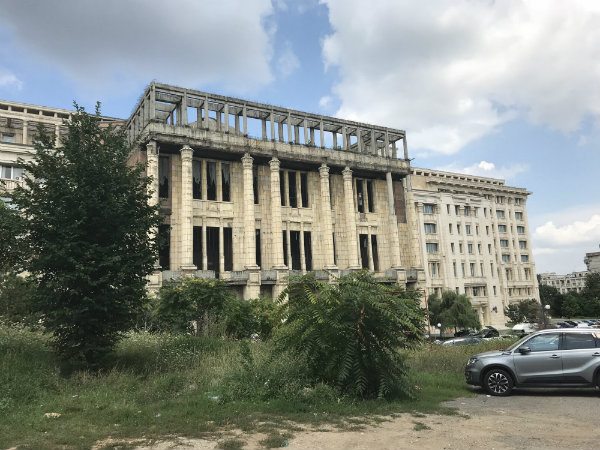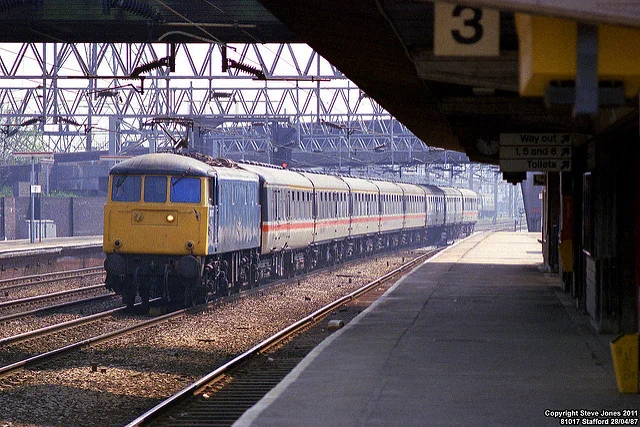The past is all around us: A tale of architecture in Bucharest
I was surprised by how hot Bucharest was in July. I had assumed that a city in a former Communist, Eastern European Country would have permanent grey skies and light drizzle. This, of course, more accurately describes the London climate and not the climate of a city that is roughly as far south Milian or Lyon. This was an assumption I made based on how Bucharest looks, ie very Soviet.
Romania is the place that first comes to mind when people think about Eastern European Communist countries. It had a self obsessed, power mad, authoritarian dictator in the form of Nicolae Ceausescu. During Ceausescu’s 24 years in power he committed many crimes against humanity, as well as ordering the construction of buildings that would make the judges of the Carbuncle Cup weep. His style of building was greatly influenced by a visit to North Korea, as was his ordering of huge military parades for his own self-aggrandisement.
I spent an afternoon in the baking Bucharest July sun looking at huge, grey buildings and trying to understand the lives of the people who lived there. Many of these lives overlap with my own (there are still former Communist politicians in the Romanian parliament) but their lives seem as alien to me as those of people of Victorian Britain. The fact that their TV only showed two hours of broadcast a day that was entirely propaganda speeches from Communist leaders and that it was illegal to consume media from outside the country, was one striking fact that stayed with me. In truth I struggle to imagine that it would be like to live in such a society.
My initial conclusion, after spending an afternoon walking around the decaying ruins of what seemed to me like another world, is that Bucharest lives up to its reputation of having a lot of very large, very grey, very Soviet buildings. The most famous of these is the Palace of the Parliament, the world's largest parliament building and second largest government building (behind the Pentagon). This eleven story high structure dominates the skyline of Bucharest just as Castle Rock dominates Edinburgh. Surprisingly it is even larger underground than it is above. Just to remove any doubt, that is the building pictured at the top of this page.
Most of Bucharest's large and grey buildings were began in the 1980s when Ceausescu went on a building rampage that involved demolishing a 6th of the city. He was overthrown in a violent revolution that fitted his blood soaked rule in 1989 and most of the construction was put on hold. The revolution resulted in Ceausescu and his wife, Elena Petrescu, being executed on live TV. You can watch this clip on YouTube if you really want. I am not linking to that here, because it is the actual footage of actual human beings being shot to death.
Since the revolution, legal disputes between the current and former occupiers of land that was confiscated by the Communist government has meant that construction on my buildings has not continued and maintenance has not been done. Many buildings remain half finished or have been abandoned. This gives the city is ruinous, dystopian feel.
Bucharest has been doubly damaged, first by having a lot of its 19th century neoclassical buildings pulled down, then by what was put up in their place left unfinished and now much of it falling into legal limbo and ultimately ruins. Many buildings had unfinished facades like the example below:
The double presence of the architectural excesses of an authoritarian regime and then the decay of something that capitalism sees no value in, does give Bucharest a decaying, run down feel. This is not a city that inspires much affection. Although, the beer is gloriously cheap.
It is not that Bucharest's buildings are without merit. Many are fine examples of the socialist realistic or socialist functionalist style of architecture. Especially those designed as residents for Communist Party officials that can be found along the Victory of Socialism boulevard. These are fine examples of a socialist interpretation of the neoclassical view of architecture.
What these buildings have in common with modernist architecture - a style that doesn't seem to have had much impact on Bucharest as dictators generally disliked the artistically challenging and personally expressive nature of modernism - is that these are buildings that the people of Romania are trying to put behind them just as Britain has spent the last 40 years trying to put the modernism, of 1950 and 60s councils behind us. Our guide on the tour declared that there was only one Communist building of merit in Bucharest, a concert hall that I was unable to photograph. Many people will see similarities (both architecturally and philosophically) between the Palace of the Parliaments and Birmingham Central Library, ie they were imposed on people and stand radically against the public’s perception of beauty.
The similarities between Bucharest's socialist functionalist buildings and the modernist buildings in Western Europe, is that these buildings doesn't apologise for themselves or seek to flatter bourgeoisie aesthetic tastes. These buildings have ambition and work on a scale that are much bigger than individual humans. The monumental scale of Bucharest's buildings is their architectural merit. They possess, what Jonathan Meades has called the architecture of the sublime, a rare character posed by the buildings of great architects from John Vanbrugh to Le Corbusier.
That said, Bucharest's buildings have all the hallmarks of totalitarianism. I can see why people find these buildings ugly. They go against conventional taste, and I am not enough of a snob to say that conventional taste is entirely invalid. Furthermore, I can see why the people of Bucharest want to put their past and these buildings (which are an ever present reminder of the past) behind them. I didn’t seem confident enough in my convictions of the merits of Bucharest's architecture (or enough of a dickhead) to argue with a local guide’s summary of the city.
The problem is that Bucharest is struggling to put the past behind it because of the scale of the past. Bucharest is currently building the world's largest Orthodox Church (pictured below) that will be taller than the Palace of the Parliaments. I am not sure the solution to having a city based around a large building that has aged poorly is to construct a large building that will probably age poorly. Certainly the leaders of Romanian haven't lost their appetite for monumental building.
It is impossible to defend the regime that made Bucharest the way it is, even for diehard socialists. It killed people and crushed liberty on a scale only imagined in Orwell's 1984. Bucharest has the feeling that monumental mistakes were made here and now people are paying for those mistakes. Such is Bucharest disdain for its own past that the memorial to those who died in the 1989 Revolution is broken and covered in graffiti.
Are the people any better off now? Certainly they can’t be arrested for listening to foreign media anymore, which has to be an improvement. The transition to capitalism and western democracy has brought liberty to the people of Romania, but it has also brought its own problems. Corruption and legal disputes are a blight on their economy and the aesthetics of Bucharest.
Bucharest serves as a reminder that bringing down an authoritarian regime doesn’t solve all the problems. The people are better off with Ceausescu gone, but a lot of reform is needed to make Romania a prosperous country. Western capitalism promises more than liberty with poverty and it needs to make good on these promises. In Bucharest the jury is still out on whether it has made good on these promises.
The past leaves long marks on the present and takes a long time to get over it. People and places don’t change overnight or even over decades. The built environment that the past leaves behind is a reflection of this.










